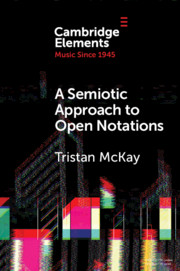Element contents
A Semiotic Approach to Open Notations
Published online by Cambridge University Press: 01 April 2021
Summary
Information
- Type
- Element
- Information
- Series: Elements in Music since 1945Online ISBN: 9781108884389Publisher: Cambridge University PressPrint publication: 29 April 2021
Bibliography
Accessibility standard: Unknown
Why this information is here
This section outlines the accessibility features of this content - including support for screen readers, full keyboard navigation and high-contrast display options. This may not be relevant for you.Accessibility Information
- 13
- Cited by
